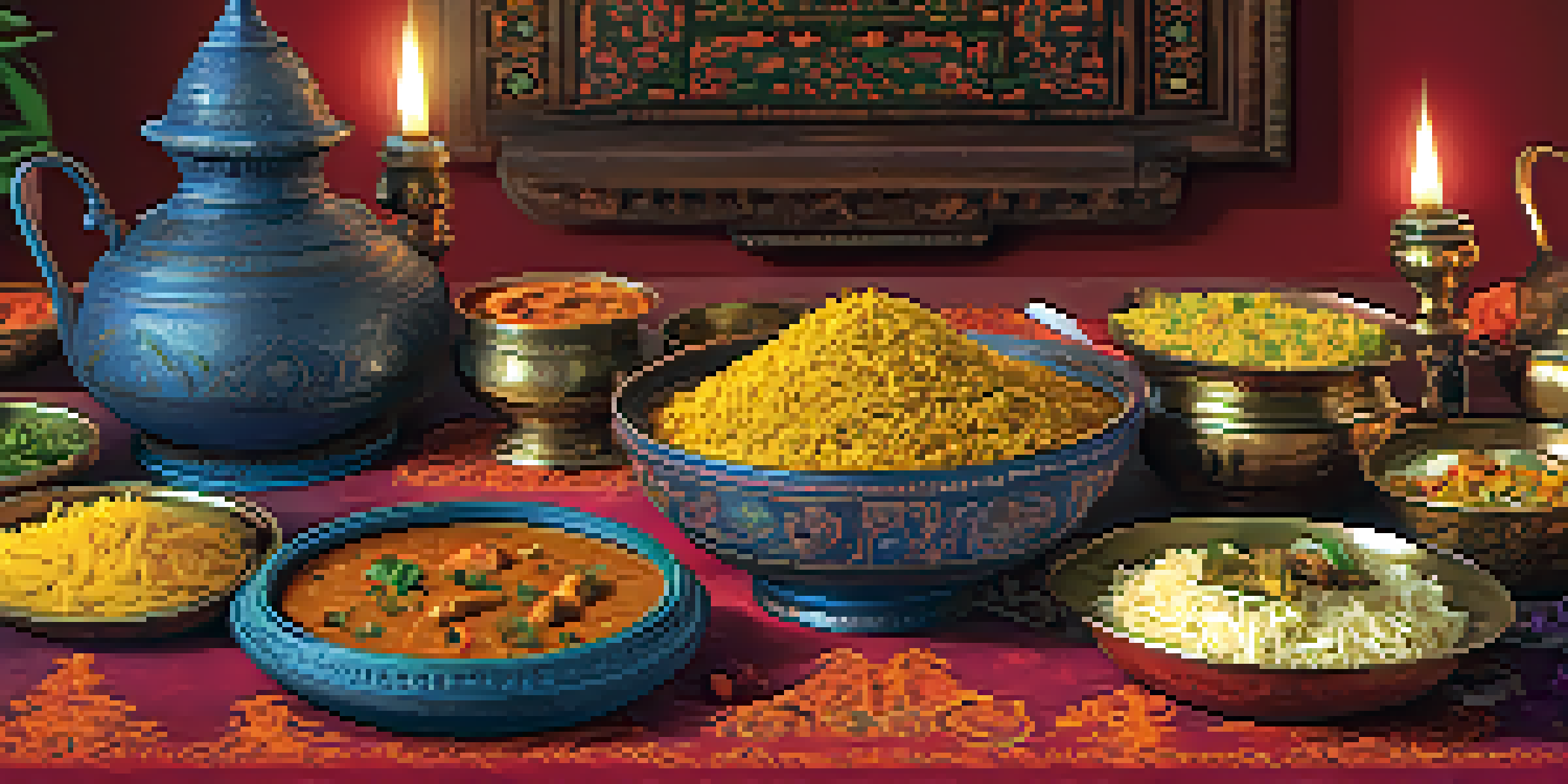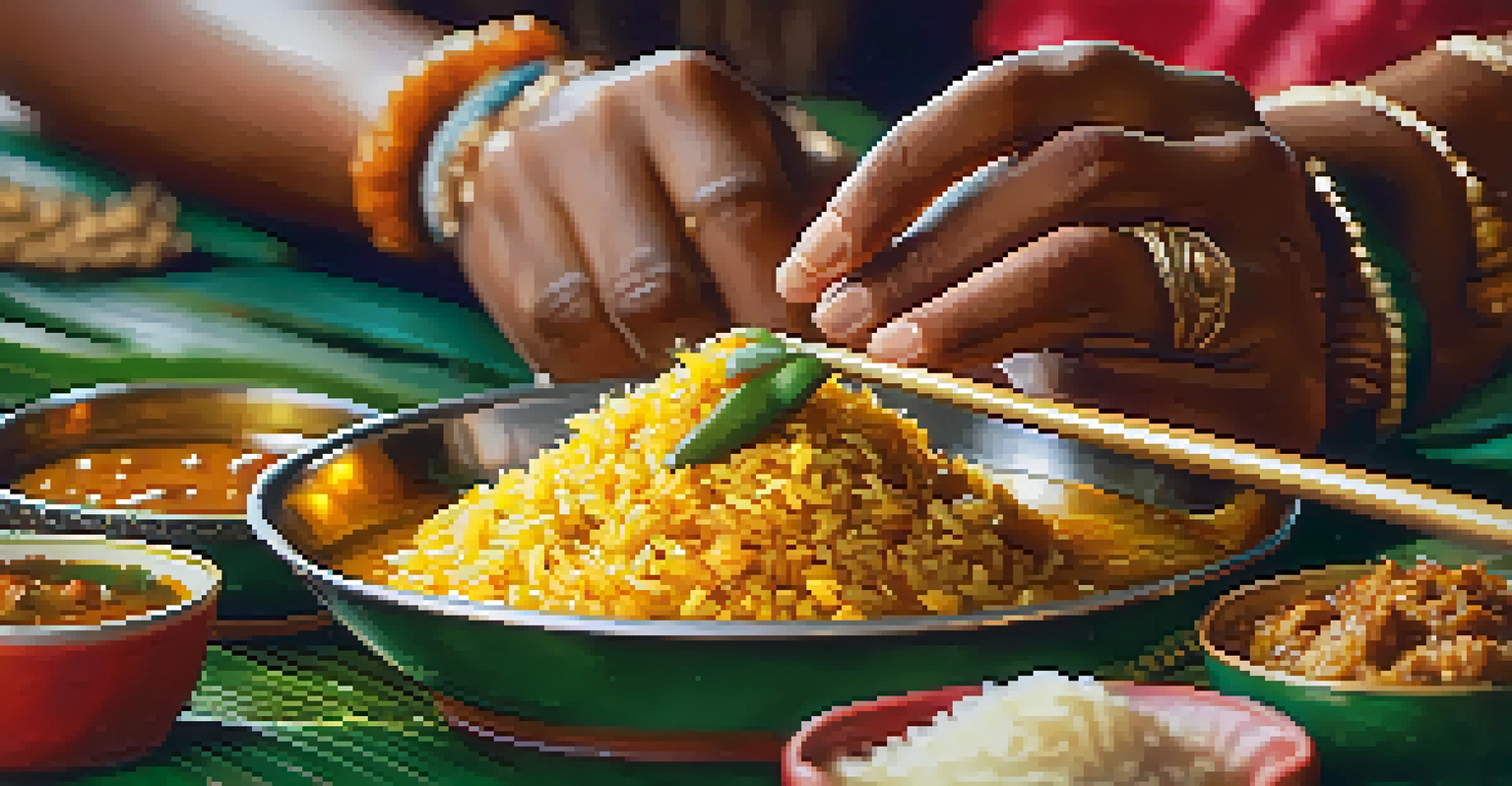Dining Etiquette in India: Table Manners and Customs

Understanding the Importance of Dining Etiquette in India
Dining etiquette in India is not just about table manners; it's a reflection of culture and respect. Meals are often seen as a communal experience, where sharing food symbolizes hospitality and bonding. Understanding these customs can enhance your experience when dining in Indian homes or restaurants.
Food is a symbol of love when words are inadequate.
In India, the way you eat and interact at the table can convey respect for your hosts and appreciation for the food. Simple gestures, like waiting for everyone to be served before starting to eat, show consideration. This practice emphasizes the importance of togetherness during meals.
Moreover, being aware of dining etiquette can help avoid unintentional faux pas. For instance, using your right hand to eat is customary, as the left hand is traditionally considered unclean. Learning these nuances can make your dining experience more enjoyable and respectful.
Common Table Manners Everyone Should Know
When dining in India, one of the most fundamental manners is to wash your hands before and after meals. This practice symbolizes cleanliness and respect for the food you are about to consume. Often, hosts will provide a bowl of water for this purpose, sometimes even scented with rose petals.

If you're invited to someone's home, it's polite to wait for your host to start the meal. This shows respect and appreciation for their hospitality. Additionally, it's common for guests to compliment the food, a gesture that acknowledges the effort put into the meal.
Dining Etiquette Reflects Culture
Understanding dining etiquette in India enhances your experience and shows respect for cultural customs.
Another important aspect is to avoid wasting food. In many cultures, including Indian, leaving food on your plate can be seen as disrespectful. If you find yourself full, it’s perfectly acceptable to take smaller portions to avoid waste, demonstrating gratitude for the meal.
Using Hands vs. Cutlery: The Indian Way
In India, many people prefer to eat with their hands, especially in traditional settings. This practice is not only cultural but is also believed to enhance the experience of enjoying food. Eating with your hands allows you to feel the texture of the food, making the meal more engaging.
Sharing food is a universal language of kindness.
If you choose to eat with your hands, remember to use only your right hand, as the left hand is reserved for other activities. Typically, the thumb and first two fingers are used to form a scoop, helping you pick up rice or bread. This may feel unusual at first, but with practice, it becomes second nature.
However, in urban settings and restaurants, you will also find cutlery being used. It's perfectly acceptable to use forks, spoons, or knives, especially when dining with people who might be more accustomed to Western dining habits. The key is to adapt to the setting while remaining respectful of the traditions.
Significance of Sharing Food in Indian Culture
Sharing food is a vital aspect of Indian culture, symbolizing unity and hospitality. When dining, it’s common for dishes to be placed in the center of the table for everyone to share. This communal style fosters a sense of togetherness and encourages conversation among diners.
Additionally, offering food to guests is seen as a mark of respect and warmth. It's customary for hosts to ensure that their guests have enough food and drink throughout the meal. This practice highlights the importance of generosity in Indian culture.
Importance of Sharing Food
Sharing food symbolizes unity and hospitality, fostering a sense of togetherness during meals.
Even in more formal dining settings, the idea of sharing remains prevalent. It’s not unusual to see platters being passed around, inviting everyone to take a taste. This approach not only enhances the dining experience but also allows everyone to savor a variety of flavors.
Respecting Dietary Restrictions and Preferences
India is a land of diverse cultures and religions, which is reflected in its culinary practices. Many individuals may have dietary restrictions based on religious beliefs, health reasons, or personal choices. Being mindful of these preferences is crucial when dining with others.
For example, many Hindus are vegetarians, while Muslims may avoid pork, and Sikhs often refrain from eating meat. If you're unsure about someone's dietary preferences, it's perfectly acceptable to ask politely. This consideration can help create a more inclusive dining environment.
When hosting or sharing food, try to include a variety of options that cater to different dietary needs. This not only shows respect for your guests but also enriches the dining experience, allowing everyone to enjoy the meal together.
The Role of Beverages in Indian Dining Etiquette
Beverages play an essential role in Indian dining culture, often accompanying meals to enhance flavors and refresh the palate. Water is typically served first, and it's polite to accept it graciously. In many households, offering chai (tea) after a meal is a common practice, symbolizing hospitality.
In formal settings, alcoholic beverages may also be offered, but it’s important to be aware of cultural sensitivities. Some guests may prefer not to drink due to personal beliefs or health reasons. Always gauge the comfort level of your dining companions before indulging.
Respect Dietary Preferences
Being mindful of dietary restrictions is crucial for creating an inclusive dining environment.
Lastly, when drinking from a shared glass or bottle, it’s customary to take small sips and avoid touching the rim. This practice maintains cleanliness and respect for communal dining. Being attentive to these customs can enhance your overall dining experience.
Expressing Gratitude After the Meal
At the end of a meal, expressing gratitude is a significant aspect of dining etiquette in India. A simple 'thank you' to your host goes a long way in showing appreciation for their effort and hospitality. This gesture fosters goodwill and strengthens relationships.
In many cultures, including Indian, it’s also common to compliment the food. Sharing what you enjoyed about the meal can make your host feel valued. Phrases like 'This was delicious!' or 'I loved the spices in this dish!' can be very encouraging.

Finally, if you're dining out, leaving a tip is another way to express gratitude. While tipping is not as customary in India as in some Western cultures, it’s becoming more accepted in urban areas. A small gesture, like rounding up the bill, can show appreciation for good service.